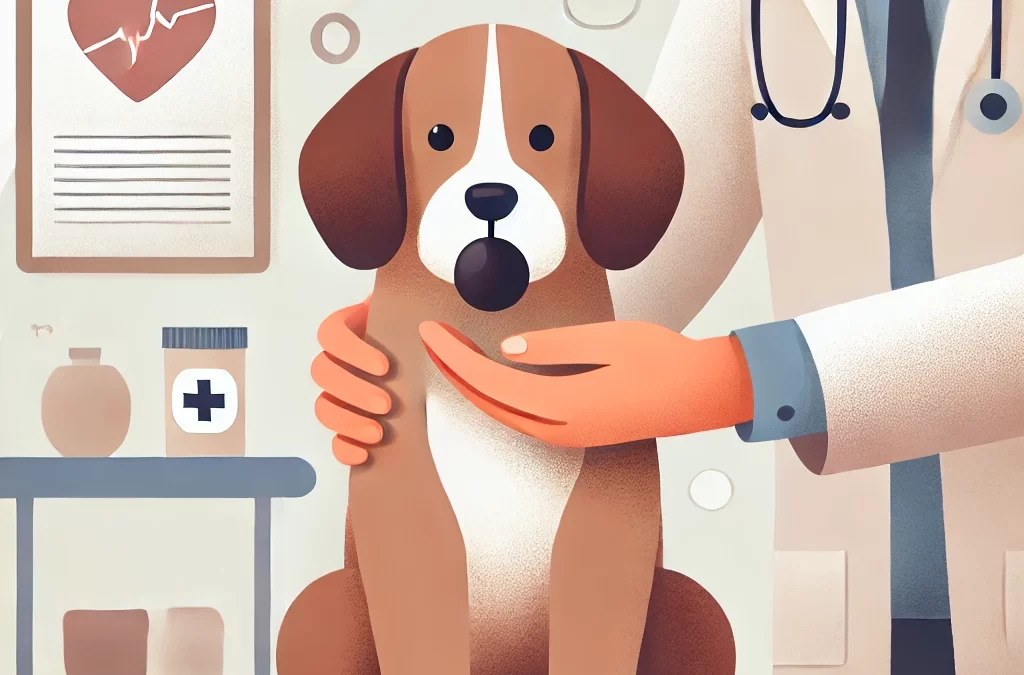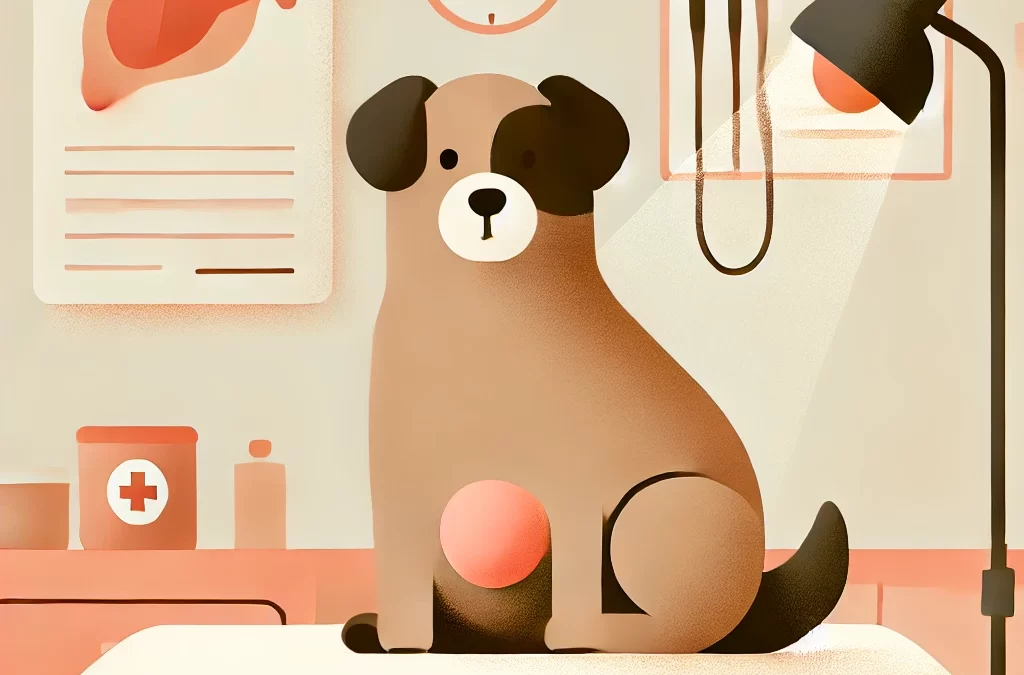
執筆者 TCMVET | 2024年12月20日 | 犬の癌と腫瘍
犬のがんは、ペットの飼い主にとって長い間懸念事項でした。この診断に直面すると、圧倒される気持ちになるのは当然ですが、原因を理解することで、予防とケアについての洞察が得られます。この記事では、犬のがんの背後にある潜在的な原因を詳しく調べ、遺伝的、環境的、およびライフスタイルの要因に光を当てます。
遺伝的素因:静かなる推進力
犬が癌を発症する主な理由の 1 つは遺伝です。特定の犬種は遺伝的特徴により癌になりやすい傾向があります。たとえば、ゴールデン レトリバー、ボクサー、ロットワイラーはリンパ腫や骨肉腫などの癌を発症する可能性が高いことが知られています。この遺伝的素因は、リスクを最小限に抑えるための責任ある繁殖方法の重要性を浮き彫りにしています。
環境毒素:目に見えない脅威
犬は飼い主が気づかないうちに環境毒素にさらされることがよくあります。殺虫剤、除草剤、受動喫煙、さらには家庭用洗剤もがんの発症に寄与する可能性があります。これらの有害物質に長期間さらされると、細胞の変異が引き起こされ、最終的には腫瘍の成長につながります。
食事と肥満:リスクを高める
必須栄養素が不足していたり、加工食品を多く摂取する不健康な食事は、犬の免疫系を弱め、がんにかかりやすくします。肥満は体内に炎症環境を作り出し、問題をさらに悪化させます。抗酸化物質を豊富に含むバランスの取れた食事を維持し、食べ過ぎを避けることで、リスクを大幅に減らすことができます。
老化:自然な要因
犬は年を取るにつれて細胞が消耗し、がんになる可能性が高まります。高齢犬は免疫機能が低下することが多く、異常な細胞が抑制されずに増殖します。そのため、早期発見と介入のためには定期的な獣医の診察が不可欠です。
過剰ワクチン接種と医学的要因
いくつかの研究では、過剰なワクチン接種や不必要な医療処置が癌のリスクを高める要因となる可能性があることが示唆されています。ワクチンは病気の予防に不可欠ですが、過剰なワクチン接種や不適切なタイミングでのワクチン接種は犬の免疫系に負担をかける可能性があります。信頼できる獣医に必ず相談して、犬のニーズに合ったワクチン接種計画を立ててください。
日光への曝露と紫外線によるダメージ
毛の色が薄い犬や毛が薄い犬の場合、日光に過度にさらされると、特に色素の少ない部分で皮膚がんを引き起こす可能性があります。ペットに安全な日焼け止めで犬を保護したり、日差しが強い時間帯の屋外活動を制限したりすることが役立ちます。
リスクを最小限に抑える方法
- バランスのとれた栄養: 犬の年齢、品種、活動レベルに合わせた高品質の食事を与えてください。ブルーベリーやニンジンなどの天然の抗酸化物質源を含めてください。
- 毒素への曝露を制限する: ペットに安全な洗浄製品を使用し、犬を殺虫剤やタバコの煙にさらさないようにしてください。
- 定期的な運動: 定期的な運動を通じて健康的な体重を維持しましょう。
- 定期的な獣医の診察: 潜在的な健康問題を早期に発見するために、毎年の健康診断と検査をスケジュールしてください。
- カスタマイズされたワクチン接種計画: 獣医師と協力して、犬のライフスタイルと健康状態に合った予防接種スケジュールを立てましょう。
終わりに
犬のがんは、遺伝的、環境的、ライフスタイル的要因が複雑に絡み合った複雑な病気です。すべてのリスクを排除することは不可能ですが、積極的な対策を講じることで、がんになる可能性を大幅に減らすことができます。飼い主は、常に情報を入手し、注意を払うことで、愛犬に最善のケアと生活の質を提供できます。

執筆者 TCMVET | 2024年12月18日 | 犬の癌と腫瘍
リンパ腫は犬に最も多く見られる癌の 1 つです。化学療法などの治療で管理できる場合が多いですが、介入にもかかわらず病気が進行することもあります。愛犬の命が終わりに近づいている兆候を認識することで、愛犬を安心させ、十分な情報に基づいたケアの決定を下すことができます。末期リンパ腫の兆候を理解し、この困難な時期に愛するペットをサポートする方法についてのガイドをご紹介します。
犬のリンパ腫を理解する
リンパ腫は、免疫系の一部であるリンパ系に影響を及ぼします。リンパ節、脾臓、肝臓、消化管など、体のさまざまな部位に現れることがあります。病気の進行はさまざまですが、進行するにつれて、体はますます弱くなり、身体的および行動的な大きな変化につながります。
あなたの犬がリンパ腫で死にかけているかもしれない兆候
重度の疲労と無気力
リンパ腫が進行した犬は、極度の疲労感を示すことがよくあります。かつては活発だったペットが、一日の大半を眠ったり横になったりして過ごし、かつて楽しんでいた活動にほとんど興味を示さなくなることがあります。
呼吸困難
胸部のリンパ腫は肺の周りに液体の蓄積を引き起こし、犬の呼吸を困難にします。兆候としては、呼吸が速い、呼吸が浅い、呼吸に苦労するなどがあります。
食欲減少
死にかけの犬は、体が機能停止していることを示すため、食べたり飲んだりすることを拒否することがあります。お気に入りのおやつさえも食べられなくなるかもしれません。
体重減少と筋肉の衰え
病気が進行するにつれて、著しい体重減少と筋肉の消耗(悪液質)が顕著になります。犬の肋骨と背骨がより顕著になることもあります。
リンパ節の腫れ
リンパ節の腫れはリンパ腫の特徴的な兆候ですが、病気が最終段階に近づくにつれて、その大きさは劇的に大きくなる可能性があります。
嘔吐と下痢
リンパ腫が消化管に影響を及ぼすと、犬は慢性的な嘔吐、下痢、またはその両方を経験することがあります。これらの症状は脱水症状を引き起こし、さらに体を弱らせる可能性があります。
痛みと不快感
犬は、すすり泣いたり、横になることが困難だったり、動きたがらなかったりするなど、痛みの兆候を示すことがあります。痛みは、臓器の損傷、炎症、または腫瘍による圧迫によって生じることがあります。
行動の変化
犬は、寿命が近づくにつれて、内向的になることがよくあります。人との交流を避けたり、孤独を求めたり、方向感覚を失ったように見えたりすることがあります。
この時期に愛犬をサポートする方法
獣医師に相談して、犬が適切な痛みの管理と緩和ケアを受けていることを確認してください。吐き気止め、食欲増進剤、鎮痛剤などの薬は犬の快適さを改善できます。
犬が邪魔されることなく休める静かで穏やかな環境を作りましょう。柔らかい寝具を用意し、お気に入りのアイテムを近くに置いておきます。
犬が喜んで食べるなら、消化しやすい食べ物を少量与えてください。水分補給も重要ですが、無理に飲ませないでください。
優しい愛情と安心感を与えながら、ペットと充実した時間を過ごしましょう。一緒にいることで、あなたとあなたの犬の両方に大きな安らぎを与えることができます。
犬の生活の質が著しく低下した場合は、人道的な安楽死を検討してください。難しい決断ではありますが、犬の苦しみを和らげる思いやりのある方法となる可能性があります。
結論
愛犬がリンパ腫で死にかけているかもしれないという兆候に気づけば、愛犬の安らぎと健康に気を配ることができます。愛犬の歩みはそれぞれ異なり、この時期にあなたが愛情とケアを注ぐことで、愛犬の最後の日々に大きな違いが生まれます。

執筆者 TCMVET | 2024年12月18日 | 犬の癌と腫瘍
はじめに: 犬の癌治療における沈黙の敵
がん悪液質は、重度の体重減少と筋肉の消耗を特徴とする複雑な代謝症候群で、多くのがんを患う犬にみられる、症状は表に出ないが致命的な病気です。原疾患に隠れてしまうことが多い悪液質は、罹患したペットの生活の質、治療への反応、全体的な生存率に重大な影響を及ぼします。この病気を理解して対処することは、犬の総合的ながん治療にとって非常に重要です。
What is Cancer Cachexia?
がん性悪液質は単なる体重減少ではありません。全身性炎症、代謝異常、腫瘍の代謝要求の相互作用によって引き起こされる多因子疾患です。主な特徴は次のとおりです。
- 筋肉量の減少: 単純な飢餓とは異なり、悪液質は筋肉の減少を引き起こし、カロリー摂取量の増加だけでは回復できません。
- Appetite Changes: 犬は食べ物への興味の低下(食欲不振)や味覚の好みの変化を示すことがあります。
- 全身性炎症腫瘍によって引き起こされる炎症は代謝の不均衡を悪化させ、症状をさらに悪化させます。
犬に癌性悪液質が起こるのはなぜですか?
癌性悪液質の正確なメカニズムは複雑であり、癌の種類と進行度によって異なります。この症状に寄与する要因には次のものがあります。
- Tumor Metabolism特定の腫瘍は、正常な代謝プロセスを妨げる物質を分泌し、筋肉や脂肪の分解を引き起こします。
- サイトカインとホルモン炎症誘発性サイトカイン(例:TNF-α)レベルの上昇とホルモンの不均衡は、悪液質の促進に重要な役割を果たします。
- 栄養不足: 食事摂取量の減少と栄養吸収障害により犬の状態が悪化します。
犬の癌性悪液質の認識
早期発見が癌性悪液質の管理の鍵となります。以下の兆候に注意してください。
- 十分な食事を摂取しているにもかかわらず、原因不明の体重減少
- 特に背骨と後ろ足の周りの筋肉の衰え
- 疲労と活動レベルの低下
- 食欲や食行動の変化
革新的な経営戦略
万能の解決策はありませんが、多角的なアプローチは犬の悪液質の管理に役立ちます。新しい戦略をいくつかご紹介します。
- カスタマイズされた栄養サポート: 高品質のタンパク質、オメガ 3 脂肪酸、グルタミンなどの特定のアミノ酸を豊富に含む食事は、筋肉量を維持するのに役立ちます。
- Appetite Stimulantsミルタザピンやカプロモレリンなどの薬剤は食欲や食物摂取を改善する可能性があります。
- Anti-Inflammatory Therapiesオメガ 3 サプリメントと炎症経路を標的とする薬剤は、サイトカインの活性を低下させる可能性があります。
- 代謝調節薬アナモレリンやグレリン模倣薬などの薬物の研究は、筋肉の消耗を逆転させる可能性を示しています。
統合医療の役割
伝統中国医学(TCM)などの自然療法は、症状を緩和する可能性があることが示されています。黄耆や高麗人参などのハーブは免疫機能とエネルギーレベルをサポートする可能性があり、鍼治療は食欲を増進し、炎症を軽減します。
将来に向けて:さらなる研究の必要性
進歩はあるものの、獣医学では癌性悪液質の研究がまだ十分に行われていません。新しい治療法を開発し、罹患した犬の転帰を改善するには、獣医師、研究者、ペットの飼い主の協力が不可欠です。
結論: イノベーションによる希望
癌性悪液質は大きな課題をもたらしますが、この症状の理解と管理の進歩は希望をもたらします。総合的かつ積極的なアプローチを採用することで、癌と闘う犬の生活の質を向上させ、尊厳と安らぎをもって老後を楽しめるよう支援することができます。

執筆者 TCMVET | 2024年12月16日 | 犬の癌と腫瘍
犬の口腔悪性黒色腫 (OMM) は、ひそかな敵です。その攻撃的な性質と急速な広がりで知られるこの病気は、ペットの飼い主に恐怖を植え付ける診断です。しかし、OMM は単なる病状ではありません。ペットの飼い主に警戒、革新、総合的なケアを取り入れるよう呼びかけるものです。この難しいテーマを新たな視点で掘り下げ、科学と希望の両方を探ってみましょう。
口腔悪性黒色腫とは何ですか?
口腔悪性黒色腫は、皮膚や粘膜の色素生成を担う細胞であるメラノサイトから発生する癌の一種です。この癌は口内に最もよく現れますが、それだけに留まりません。近くの組織に侵入し、肺やリンパ節などの離れた臓器に転移する能力があることで有名です。
この病気は中年から高齢の犬に最も多く見られ、特にコッカースパニエル、チャウチャウ、スコティッシュテリアなど歯茎の色素が濃い犬種に多く見られます。OMM は恐ろしい病気ですが、その兆候と治療の選択肢を理解することで、飼い主は十分な情報に基づいた決定を下すことができます。
兆候を認識する
口腔悪性黒色腫は進行するまで気づかれないことが多いため、定期的な口腔検査が重要です。一般的な兆候は次のとおりです。
- 口、歯茎、または唇に生じる黒っぽいまたは不規則な塊。
- 出血、口臭、よだれ。
- 食べること、噛むこと、飲み込むことが困難。
- 顔面の腫れまたはリンパ節の腫れ。
これらの症状に気付いた場合は、すぐに獣医師に相談してください。早期発見は結果に大きな影響を与える可能性があります。
伝統的な治療法を超えて:イノベーションを受け入れる
OMM の従来の治療法には、手術、放射線療法、化学療法などがあります。多くの場合、これらの治療法は効果的ですが、必ずしも利用しやすく、費用も手頃というわけではありません。注目を集めている革新的で統合的なアプローチをいくつかご紹介します。
- 免疫療法ワクチン: 腫瘍学の画期的な進歩である、犬の黒色腫ワクチン (ONCEPT®) などの OMM 専用ワクチンは、犬の免疫系を刺激して癌細胞と戦います。この最先端の治療法は、生存期間の延長に効果があることが示されています。
- 光線力学療法(PDT): この技術は、光活性化薬剤を使用して、周囲の健康な組織を温存しながら癌細胞を選択的に破壊します。特定のケースでは、より侵襲性の低い選択肢となります。
- ホリスティックサプリメント: クルクミン(ウコンに含まれる)、薬用キノコ、オメガ 3 脂肪酸などの天然サプリメントは、抗炎症作用や免疫力を高める作用があることが研究されています。サプリメントを与える前に必ず獣医に相談してください。
回復における食事の役割
がんと診断された場合、食事戦略の変更が必要になります。OMM と闘う犬は、代謝のニーズに合わせた食事から恩恵を受けます。次の点に重点を置きます。
- 高品質のタンパク質: 筋肉量を維持するために赤身の肉と魚を摂取しましょう。
- 健康的な脂肪: 炎症を抑え、全体的な健康をサポートするオメガ 3 脂肪酸。
- 低炭水化物オプション: がん細胞は糖分を栄養源として増殖するため、炭水化物を制限するとがん細胞の増殖を遅らせることができます。
獣医が認可した手作りの食事は、犬が最適な栄養を摂取できるようにする素晴らしい方法です。
ペットの飼い主への精神的かつ実践的なサポート
OMM を患う犬の世話は、困難であると同時に、精神的にも負担がかかります。この旅を乗り切る方法は次のとおりです。
- 毎日のケアルーチンを作成します。 一貫性を確立することで、あなたとあなたの犬の両方のストレスを軽減することができます。
- コミュニティのサポートを求める: 犬の癌と闘うペットの飼い主のためのオンライン フォーラムや地域のサポート グループは、慰めと貴重な洞察を提供することができます。
- 緩和ケアの選択肢を探る: 治癒的治療が選択肢にない場合は、痛みの管理と犬の生活の質の向上に重点を置いてください。
希望の光
犬の口腔悪性黒色腫は手強い敵ですが、獣医学と統合医療の進歩により状況は変わりつつあります。早期発見、革新的な治療法、そして全体的な健康への重点により、ペットの飼い主はこの病気と戦う力を得ています。
あなたの犬の診断結果は、旅路を定義するものではありません。それは、犬の回復力、愛、そしてあなたとの絆の物語の一章です。質問を続け、解決策を探し、一瞬一瞬を大切にしてください。

執筆者 TCMVET | 2024年12月16日 | 犬の癌と腫瘍
犬のお腹にしこりが見つかると、不安になります。ペットの飼い主として、まず心配になることが多いのですが、しこりのすべてが危険なわけではありません。実際、多くは良性で、適切なケアで対処できます。この状況を切り抜けるために、犬のお腹のしこりを理解し、特定し、対処するための新しい視点をご紹介します。
胃のしこりとは一体何でしょうか?
犬の胃のしこりとは、腹部に異常な塊や腫れがあることを意味します。大きさ、形、質感はさまざまで、柔らかくて動くものもあれば、硬かったり、下層組織に付着しているものもあります。
このようなしこりに対処する鍵は、観察とタイムリーな対応にあります。結論を急ぐ前に、これらの腫瘍の最も一般的な原因を探ってみましょう。
胃のしこりの一般的な原因
- 脂肪腫(脂肪性腫瘍): これらは良性で柔らかく、ゆっくりと成長するしこりで、高齢の犬によく見られます。脂肪腫が健康上のリスクとなることはほとんどなく、通常は美容上の問題です。
- 血腫または膿瘍: 犬が最近外傷を負った場合、しこりは血腫(皮膚の下に血液が溜まったもの)または感染によって生じた膿瘍である可能性があります。これらは通常、温かく、触ると痛みを感じます。
- ヘルニア: ヘルニアは、内部の組織や臓器が腹壁の弱い部分から押し出されることで発生します。柔らかく感じられ、軽く押すと軽減することがあります。
- 悪性腫瘍: 残念ながら、しこりの中には癌性のものもあります。肥満細胞腫、軟部肉腫、その他の悪性腫瘍は、多くの場合、獣医による迅速な診察と治療を必要とします。
- 嚢胞または皮脂腺の増殖: これらは、犬のお腹にできる、液体で満たされた袋や詰まった腺であることが多いです。通常は無害ですが、大きくなりすぎると、液体を排出したり、簡単な手術が必要になる場合があります。
すぐに注意が必要な兆候
すべての胃のしこりが心配の原因となるわけではありませんが、特定の症状は緊急に獣医の診察が必要であることを示しています。
- しこりは急速に大きくなります。
- その部分に触れると犬は痛みを感じているように見えます。
- しこりは硬く、動かず、または不規則な形をしています。
- その部分に赤み、腫れ、または分泌物があります。
- あなたの犬は無気力、食欲不振、またはその他の全身的な問題の兆候を示しています。
しこりを発見したらどうするか
- しこりを監視する: サイズ、質感、行動を記録してください。数日ごとに写真を撮ると、変化に気づくのに役立ちます。
- 獣医の診察を予約する: 獣医師は身体検査を実施し、腫瘍の性質を判断するために穿刺吸引、生検、超音波検査などの診断検査を勧める場合があります。
- 治療オプションを検討する: 診断結果に応じて、獣医は観察、投薬、手術、またはその他の治療法を提案する場合があります。脂肪腫のような良性腫瘍の場合、しこりが不快感を引き起こさない限り、治療は必要ない場合もあります。
- 自然療法を調べる(獣医の承認あり): 悪性でない腫瘍の場合、ペットの飼い主の中には、ウコン、オメガ 3 脂肪酸、または全体的な免疫の健康を促進するハーブ療法などの天然サプリメントに頼る人もいます。新しいサプリメントを与える前には必ず獣医に相談してください。
健康な犬のための予防のヒント
- 定期検診: しこりを効果的に管理するには、早期発見が鍵となります。定期的に獣医の診察を受けることで、変化があればすぐに対処できます。
- バランスの取れた食事: 栄養豊富な食事は犬の全体的な健康と免疫力をサポートします。
- 健康的な体重を維持する: 肥満は脂肪腫やその他の健康問題のリスクを高めます。犬を活発に活動させ、理想的な体重を維持してください。
- スキンケア: 犬の毛や皮膚を定期的に手入れして検査することで、異常を早期に発見することができます。
慰めの言葉
すべてのしこりが命にかかわるわけではありません。獣医学の進歩により、診断と治療はかつてないほど効果的になりました。注意深く積極的に観察することで、愛犬が幸せで健康な状態を保つことができます。
お腹にしこりがあることに気づいたら、深呼吸して獣医に相談してください。一緒に、あなたの愛犬にとって最善の道を見つけましょう。
タグ: 犬の胃のしこり、犬のしこりの原因、犬のしこりの治療、犬の健康管理、犬の良性腫瘍、犬の自然療法





